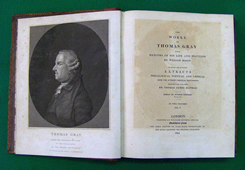Textual Sources & Publication
The version of Gray's 'Journal' that is used on this website is taken from his correspondence, but the text has a relatively complex history as it underwent several important authorial and non-authorial developments over the course of its life-time. The text began life in notebooks and familiar letters, as a private record of travel, but through posthumous editing and publication it was transformed into a Lakeland guide for tourists.
Gray initially composed the 'Journal' in two pocket notebooks which he carried with him throughout his tour. The notebook text was then transcribed word-for-word (with the exception of minor copying errors) into a series of letters, which Gray sent to Wharton. The first letter, containing 'Journal' entries from 30th September-1st October, was sent by Gray from Aston on the 18th October 1769. Three subsequent letters, covering entries from the 1st-3rd, 3rd-4th and 5th-8th of October, were then sent from Cambridge in October and November 1769, and January 1770 respectively. For reasons unknown, the final instalment of the text, which consists of entries from the 8th-14th of October, does not appear to have been sent by Gray. Instead, it was transcribed from the second of Gray's notebooks by William Mason's curate, Christopher Alderson (again with only minor copying errors), and sent, by Mason, to Wharton on 24th July 1770.
Gray's 'Journal' was not made available to the reading public until 1775, when it was published by William Mason in 'The Poems of Mr Gray: To which are Prefixed Memoirs of his Life and Writings' (1775). Mason took an active editorial role, printing the 'Journal' as a continuous text rather than in its original epistolary instalments; omitting and inserting passages; and adding an introductory paragraph and some lengthy explanatory footnotes. These changes transformed the text into a Picturesque guide, and paved the way for Mason's edition of the 'Journal' to be included as an intertext to the first edition of Thomas West's 'Guide to the Lakes' (1778), and as an appendix to the second edition (1780). It was the inclusion of the 'Journal' in West's 'Guide' that secured it a seminal place in the literary history of the Lakes, giving the text its popular identity and readership.
Mason took an active editorial role, printing the 'Journal' as a continuous text rather than in its original epistolary instalments; omitting and inserting passages; and adding an introductory paragraph and some lengthy explanatory footnotes. These changes transformed the text into a Picturesque guide, and paved the way for Mason's edition of the 'Journal' to be included as an intertext to the first edition of Thomas West's 'Guide to the Lakes' (1778), and as an appendix to the second edition (1780). It was the inclusion of the 'Journal' in West's 'Guide' that secured it a seminal place in the literary history of the Lakes, giving the text its popular identity and readership.

